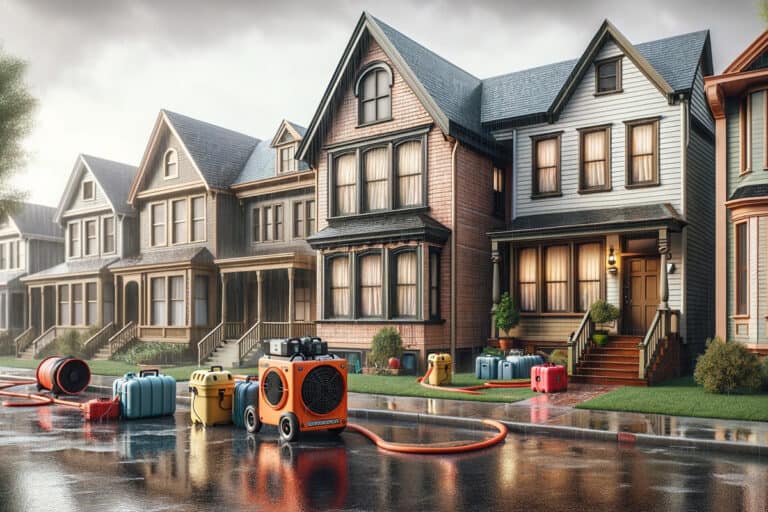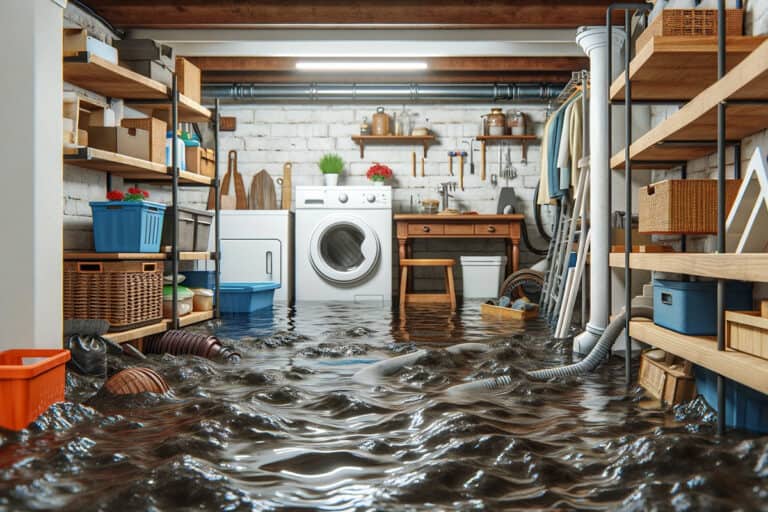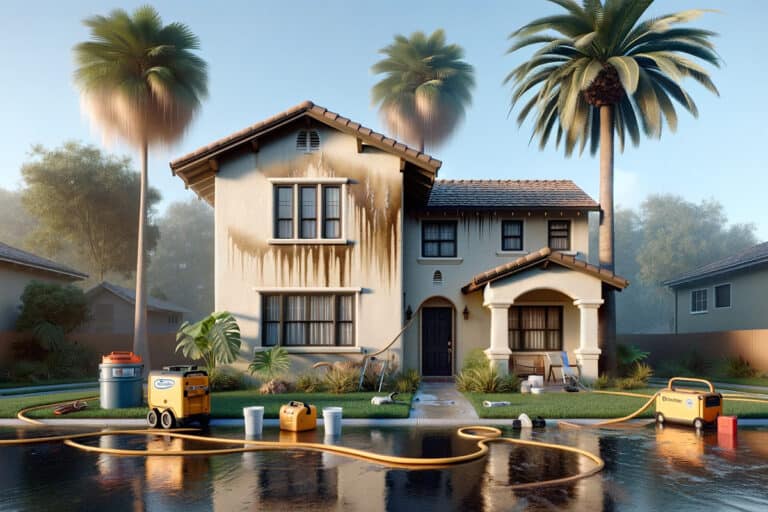Disclosure: I am compensated for purchases made through some links on this site. Click for details.
Roof water damage is a significant problem that can lead to substantial damage to your home. Addressing this issue promptly can save homeowners from hefty water damage roof repair costs and safeguard the structural integrity of their property.
When it comes to safeguarding your home, understanding the perils of roof water damage is crucial. This form of damage can lead to serious consequences, including structural issues and potential health risks. t occurs when water penetrates your roofing system, leading to issues such as leaks, stains, mold growth, and structural rot. In the United States alone, the frequency and cost of roof water damage are staggering, with homeowners spending millions of dollars annually on repairs.
The main causes of roof water damage include poor installation, age, weather conditions, and lack of maintenance. Signs of roof water damage include visible leaks, water stains on ceilings and walls, mold growth, a musty odor, and damaged shingles or flashing. This guide provides a thorough overview and actionable strategies for dealing with roof and water damage repair, so you are equipped to handle these issues effectively.
How to Identify Roof Water Damage
Being able to accurately identify roof water damage is pivotal in minimizing damage and repair costs. Here’s a detailed look at how you can inspect and pinpoint issues related to a leaky roof.
Roof and Attic Inspection
Start by inspecting your roof and attic for any signs of water damage. Look for dark or wet patches, damaged or missing shingles, and faulty flashing or gutters. Pay attention to any areas where water might be pooling or where the roof appears to be sagging. This includes sagging soffits and fascia.
Use of Tools
Tools such as moisture meters or infrared cameras can be extremely helpful in measuring the extent and severity of the damage. These instruments provide a more in-depth analysis, ensuring that no sign of roof leak damage goes unnoticed.
Moisture meters can detect the moisture content in materials, helping to identify areas of concern. Infrared cameras can visualize temperature differences in the roof, highlighting areas where water may be present.
Diagnosing the Source
Determining the source and cause of the water damage is crucial for effective repairs. This could range from issues related to weather-related damage, installation errors, or problems with the roofing design. Pay attention to any patterns or areas where water damage appears to be concentrated, as this can provide clues to the source.
Recognizing Common Damage Types
Be on the lookout for prevalent roof water damage signs such as water stains, mold growth, rot, and corrosion. These are indicative of a leaky roof and necessitate immediate attention.
Roof Water Damage Severity Scale
Refer to the following table to assess the severity of the damage and determine the next steps:
Table 2: Roof Water Damage Severity Scale
| Severity | Signs | Recommended Action |
|---|---|---|
| Minor | Small stains, no active dripping | Monitor, consider DIY repair |
| Moderate | Larger stains, occasional dripping, minor shingle damage | Schedule a professional inspection |
| Severe | Extensive water damage, active leaks, structural damage | Contact a professional immediately, consider emergency services if necessary |
How to Prevent Roof Water Damage
Preventing roof water damage is far more cost-effective than dealing with repairs. Here’s what you can do to maintain the integrity of your roof:
Regular Inspections and Maintenance
Conduct regular inspections and maintenance to identify early signs of a leaky roof. Ensure that all components of the roofing system are in good condition and functioning properly. Look for any signs of wear, deterioration, or damage. Addressing issues promptly can significantly reduce the roof leak repair cost.
Roof Maintenance Checklist
Use the following checklist to ensure you are covering all aspects of roof maintenance:
Table 2: Regular Roof Maintenance Checklist
| Task | Frequency | Purpose |
|---|---|---|
| Inspect Roof Shingles | Bi-annually | Look for damage or signs of wear and tear |
| Clean Gutters and Downspouts | Quarterly | Prevent water buildup and ensure proper drainage |
| Check for Moss and Algae | Bi-annually | Clean or treat as necessary to prevent damage |
| Inspect Flashing | Annually | Ensure that it is secure and undamaged |
| Trim Overhanging Branches | Annually | Prevent damage from branches and reduce debris |
| Check Attic Ventilation | Annually | Ensure vents are clear and functioning properly |
Proper Drainage and Ventilation
Install and maintain proper drainage systems to ensure that water is effectively channeled away from the roof. Flashing and ventilation systems are also crucial. They prevent water infiltration and reduce the risk of condensation. These elements are crucial in maintaining the longevity of your roof.
Regular Inspections
Regular inspections by a professional help to identify potential issues before they become serious. Look for a qualified contractor who can conduct thorough inspections and provide recommendations for maintenance or repairs.
Common Causes of Roof Leaks and Preventative Measures
Below is a list of common causes of roof leaks along with suggested preventative measures or solutions:
Table 3: Common Causes of Roof Leaks and Preventative Measures
| Common Causes of Roof Leaks | Description | Preventative Measures/Solutions |
|---|---|---|
| Damaged or Missing Shingles | Shingles can become cracked, broken, or go missing due to wear and tear or severe weather. | Regularly inspect and replace any damaged or missing shingles. |
| Clogged or Damaged Gutters and Downspouts | Leaves and debris can accumulate, preventing proper water drainage. | Clean gutters and downspouts regularly; consider installing gutter guards. |
| Loose or Backed Out Roofing Nails | Nails that have shifted or come loose can lead to vulnerabilities in the roofing material. | During inspections, ensure all roofing nails are secure and in place. |
| Buckling, Curling, or Granule Loss of Shingles | Over time or due to poor installation, shingles may buckle, curl, or lose granules. | Replace shingles showing signs of buckling, curling, or granule loss. |
| Damaged or Missing Flashing | Flashing seals protrusions in the roof but can become cracked, displaced, or go missing. | Ensure all flashing is intact and properly sealed; replace if necessary. |
| Incorrectly Sealed or Deteriorating Roof Valleys | The sealant in roof valleys can deteriorate over time or may have been incorrectly applied. | Regularly inspect roof valleys and reseal or repair as needed. |
| Cracks Around Chimneys | Over time, the area around chimneys can develop cracks. | Inspect and seal any cracks around chimneys. |
| Damaged Pipe Boots and Vent Collars | These elements can experience cracks, gaps, or failure over time. | Regularly inspect and replace pipe boots and vent collars as needed. |
| Aging or Improperly Installed Skylights | Skylights can deteriorate over time or may have been installed incorrectly. | Ensure skylights are properly installed and in good condition; replace if necessary. |
| Ice Dams | Ice dams can form at the edge of the roof, preventing melted snow from draining off. | Properly insulate and ventilate the attic to prevent ice dams. |
| Hail Damage | Hail can cause damage to roofing materials. | Inspect the roof after hail storms and replace any damaged materials. |
| Damage from Fallen Tree Branches | Branches can fall and damage the roof. | Regularly trim tree branches near the roof. |
By addressing these issues proactively, you can significantly enhance the longevity of your roof and protect your property from water damage.
Selecting Quality Roofing Materials and Contractors
It is essential to choose the right roofing material and contractor. Opt for high-quality roofing materials and hire reputable contractors.
To make an informed decision, research different options and consider their features, benefits, reviews, and ratings. Ensure that the contractor is experienced, licensed, and insured.
How to Repair Roof Water Damage
If roof water damage has already occurred, prompt repairs are essential. Taking swift action can significantly reduce the extent of the damage and protect your property. Here’s how to approach the repair process:
Contain the Leak
Place buckets or large containers under the leak to prevent water from damaging floors and belongings. If the ceiling is bulging, carefully puncture it with a screwdriver to relieve pressure and place a bucket underneath to catch the water.
Tarping the Roof
If your roof is leaking and you’re unable to get immediate professional help, using a tarp can be an effective temporary solution. Here’s how you can do it safely and effectively:
- Wait for Safe Conditions: Ensure that the roof is safe to climb. If it’s not, or if you’re unsure, it’s crucial to call a professional, such as a roofing company, to handle the situation.
- Locate the Problem Area: Try to identify the area on the roof that corresponds to the leak inside your property.
- Use a Quality Tarp: Choose a tarp that is at least six millimeters thick. Ensure that it extends a minimum of four feet beyond the problem area and up to the roof’s peak. If the peak is too far, tuck the top edge of the tarp under shingles and use roofing nails to secure it in place. This helps prevent water from going underneath the tarp and ensures comprehensive coverage.
Move and Protect Belongings
Quickly move any furniture, electronics, or other valuables away from the leaking area. If items can’t be moved, cover them with plastic sheets or tarps.
Document the Damage
Take photos and document the damage for insurance claims. Include damage to both your belongings and the structure of your home.
Hiring a Roof Repair Specialist
Look for a qualified and experienced roof repair contractor. Check their portfolio of work, references, positive customer reviews, and the necessary credentials to ensure they are reputable and reliable. Ensure that the contractor provides a warranty or guarantee for their work.
Comparing Quotes and Financing
Obtain multiple quotes and estimates from different contractors to compare prices and services. Consider financing options or grants that may be available to help cover the roof leak repair cost.
Estimated Roof Leak Repair Costs
Refer to this table for a breakdown of potential costs associated with repairing a leaky roof:
Table 4: Estimated Roof Leak Repair Costs
| Service/Material | Estimated Cost | Notes |
|---|---|---|
| Roof Inspection | $100 – $500 | Depending on complexity and location |
| Patching a Small Leak | $150 – $500 | Small, localized damage |
| Repairing Flashing | $200 – $500 | Repair or replacement |
| Replacing Shingles | $250 – $750 | Depending on type and extent of damage |
| Gutter Cleaning or Repair | $100 – $250 | Ensuring proper drainage |
| Professional Mold Removal | $500 – $4,000 | If water damage has led to significant mold growth |
Preparing Your Home
Before repairs begin, take steps to protect your home and belongings from further damage. This may include moving items out of the affected area, covering furniture, or creating a temporary waterproof barrier. This is a crucial step in roof and water damage repair.
Evaluating the Repair Work and Quality Assurance
Upon completion of repairs, meticulously evaluate the quality and effectiveness of the work. Make sure all issues have been addressed. Look for any signs of lingering water damage or potential issues. Confirm warranty or guarantee policies with the contractor.
How to Recover from Roof Water Damage
Recovery is the final phase in addressing roof water damage it involves several steps, including dealing with insurance claims, cleaning and restoring your home, and taking steps to prevent future damage. Here’s what you need to know:
Documenting and Reporting the Damage
Take photos and document the extent of the water damage for insurance purposes. Report the damage to your insurance company or landlord as soon as possible and file a claim if applicable.
Cleaning and Sanitizing
After repairs are complete, clean and sanitize your home and belongings to prevent mold growth and mitigate health risks. Professional cleaning services may be required for severe cases and those where mold growth has begun.
Restoring Your Home and Roof
Take steps to restore your home and roof to its pre-damage condition. This may involve replacing damaged materials, painting, sealing, or making other necessary repairs.
Claiming Tax Deductions or Rebates
Explore the possibility of claiming tax deductions or rebates for your roof water damage repairs if you are eligible. This can provide some financial relief and help offset the costs of repairs. Check with a tax professional to determine your eligibility and how to file.
Frequently Asked Questions (FAQ)
Conclusion
Roof water damage is a serious issue that requires prompt attention. From identifying the signs of a leaky roof to repairing and recovering from damage, it’s essential to take proactive steps to protect your home. Remember, timely repairs and regular maintenance are key to preventing roof water damage.
Utilizing quality materials, ensuring proper installation, and conducting regular inspections contribute to the longevity of your roof and the safety of your home. In case of damage, understanding the roof leak repair cost, options for financial assistance, and the importance of thorough cleaning and restoration cannot be overstated.
If you have any further questions please leave a comment below or consult with a professional. Remember, dealing with roof water damage promptly and effectively is crucial in maintaining a safe and secure home environment.





